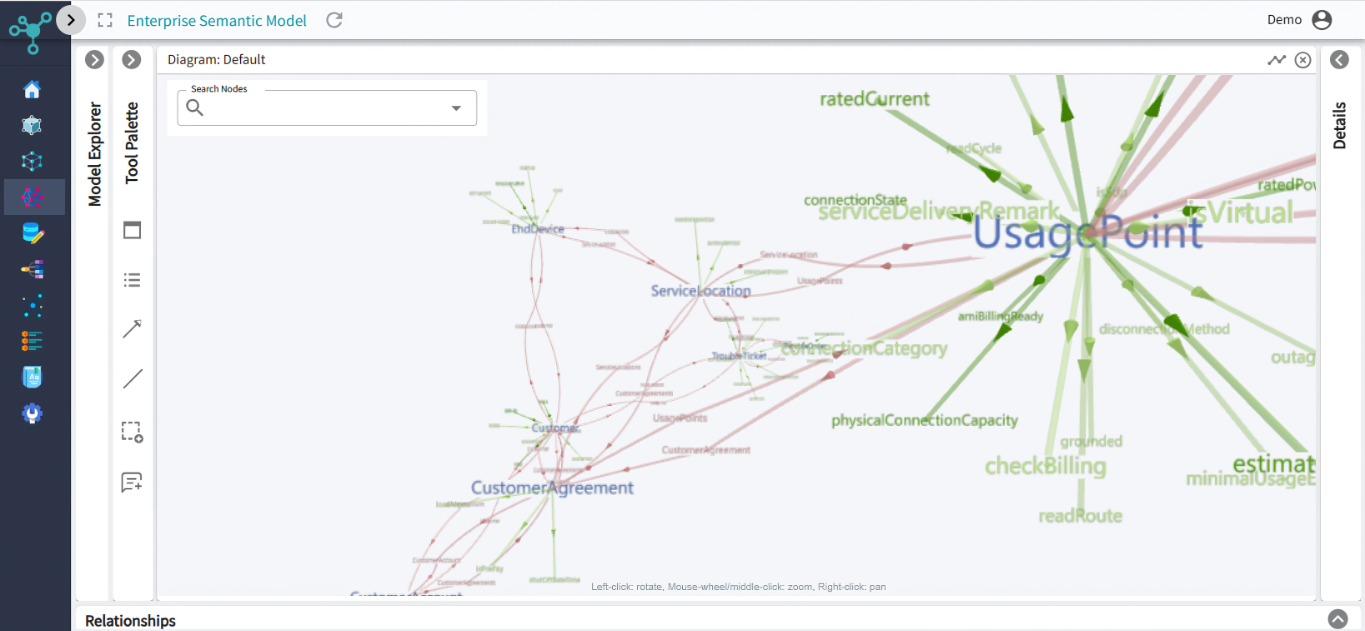To foster alignment and smarter decision-making, it's essential to understand how data moves and is applied throughout the organization. That’s why we've introduced the Knowledge Graph Viewer in the Affirma product suite—a strategic addition that offers a unified, visual representation to drive deeper insights and strengthen cross-functional collaboration.
Visualization is the key to understanding, clarity, and action.
Affirma serves as the central repository for all metadata, capturing both design elements for data-in-motion and data-at-rest. Beneath the surface lies a powerful knowledge graph that interconnects this metadata. Why is connected metadata so important? Metadata brings context, consistency, and clarity to your entire data ecosystem paving the way for:
- Better Decision-Making
- Increased Efficiency
- Accelerated Innovation
- Enhanced Collaboration
- Stronger Governance and Compliance
The Knowledge Graph Viewer is made possible by Affirma’s intentional architecture, which adopts an ontology-based approach to represent metadata. It leverages W3C standards such as OWL, SKOS (Simple Knowledge Organization System), and ODRL (Open Digital Rights Language), among others.
3D Visual View
Traditional metadata tools often rely on lists, tables, and static diagrams—how many of you are still wrangling metadata in Excel? But data rarely moves in straight lines. A 3D visual approach transforms how organizations explore and understand their data landscape, providing an interactive, multi-dimensional map that uncovers relationships, flows, and dependencies like never before for:
- Deeper Insight - View data relationships from multiple angles—business, technical, and operational—simultaneously. Understand not just where data is, but how it moves and why it matters.
- Cross-Functional Clarity - Executives, analysts, and engineers can explore the same view, tailored to the view associated with their role. This creates shared understanding and accelerates strategic alignment.
- Complexity Made Intuitive - As systems grow, so does complexity. A 3D interface simplifies exploration, enabling users to zoom in on specific data objects or zoom out to see enterprise-wide patterns.
- Strategic Visibility - It’s not just about metadata—it is about business outcomes. A 3D view helps identify bottlenecks, highlight high-impact data assets, and support smarter investments in data infrastructure.
3D metadata view is not just a prettier interface—it is a smarter way to drive data fluency, operational agility, and executive oversight in an increasingly complex digital environment.
Search and Explore Capability
A knowledge graph is a powerful way to unify complex, interconnected metadata across an enterprise, capturing relationships between systems, schemas, processes, and transformations. However, without robust and intuitive search capabilities, the richness of that graph often goes untapped. The Knowledge Graph Viewer in Affirma is designed to solve that gap, complimenting other existing views such as UML Semantic Model and Context view, and physical/artifact views (JSON, XSD, DDL, etc.). It allows users to interactively explore and query the entire metadata graph—including objects, associations, lineage mappings, business rules, and data design artifacts.
With the Viewer, you can trace data flows end-to-end, uncover hidden dependencies, validate governance policies, and accelerate impact analysis from a single interface. Whether you're designing new pipelines, assessing the ripple effect of schema changes, or aligning technical metadata with business context, the Viewer turns the complexity of your data ecosystem into actionable intelligence.
- Rapid Discovery - Search allows users to instantly surface relevant entities—whether it is people, systems, data sets, definitions, or relationships—without navigating a complex web manually.
- Unlocks Contextual Insights - It’s not just about finding a thing—it is about understanding how it fits into the bigger picture. A smart search engine leverages relationships within the graph to surface connected, contextual
- Empowers Everyone - From executives to analysts to engineers, a robust search function makes the graph accessible to non-technical users, driving broader adoption and more informed decisions.
- Accelerates Workflows - Whether someone is trying to trace data lineage, identify data owners, or validate definitions, search reduces friction and speeds up critical tasks across the organization.
- Drives Knowledge Reuse - By surfacing existing assets, insights, and documentation, search prevents duplication of work and helps teams build on what already exists.
A knowledge graph without strong search is like a library with no index. Search turns connected metadata into actionable intelligence—making it one of the most essential features for delivering business value.
The Knowledge Graph Viewer in Affirma is included in all Affirma Capability bundles.
Learn more about Affirma and how to navigate change! Speak to a member of the SemanticWorx team.



